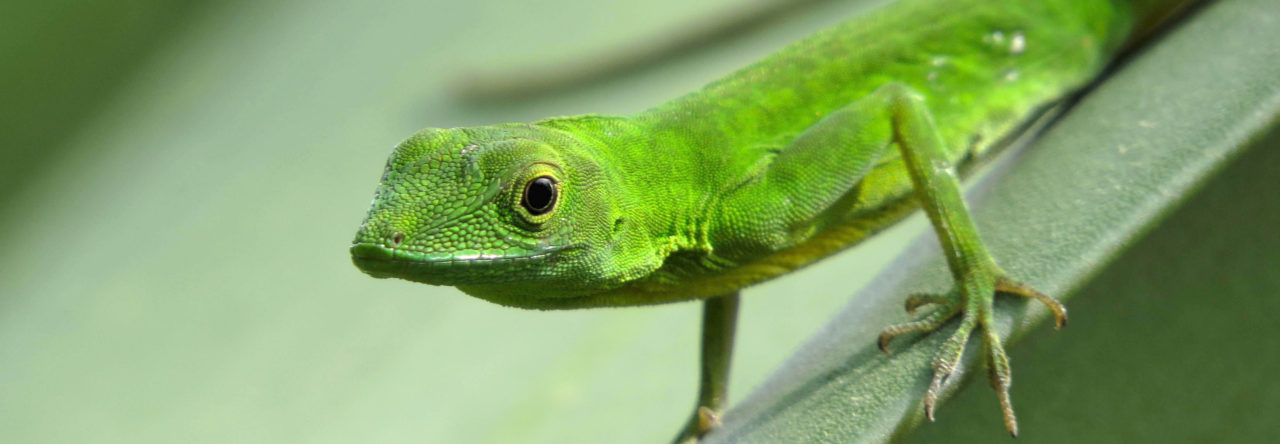 Much has been written about how differences in relative limb length allow anoles to successfully occupy distinct portions of the arboreal habitat. Most research has focused on large-scale patterns of diversity, which are presumably the result of natural selection. But limb length could also be more finely tuned using an alternative process, whereby an individual’s morphology responds to environmental cues experienced throughout development. This process is known as phenotypic plasticity. We already know that anole limbs exhibit plasticity in the lab (e.g., Losos et al. 2000, 2001 – A. sagrei; Kolbe and Losos 2005 – A. carolinensis), with lizards raised on narrow perches having shorter limbs than those raised on broad perches. But what about lizards in their natural environments; could plasticity in limb length allow lizards to become more specialized to their particular microhabitat in the wild? This was the question that Trinity University (San Antonio) undergraduate Alisa Dill asked in summer 2010, working with fellow undergraduate Andrew Battles, regular AA contributor Thom Sanger, and me.
Much has been written about how differences in relative limb length allow anoles to successfully occupy distinct portions of the arboreal habitat. Most research has focused on large-scale patterns of diversity, which are presumably the result of natural selection. But limb length could also be more finely tuned using an alternative process, whereby an individual’s morphology responds to environmental cues experienced throughout development. This process is known as phenotypic plasticity. We already know that anole limbs exhibit plasticity in the lab (e.g., Losos et al. 2000, 2001 – A. sagrei; Kolbe and Losos 2005 – A. carolinensis), with lizards raised on narrow perches having shorter limbs than those raised on broad perches. But what about lizards in their natural environments; could plasticity in limb length allow lizards to become more specialized to their particular microhabitat in the wild? This was the question that Trinity University (San Antonio) undergraduate Alisa Dill asked in summer 2010, working with fellow undergraduate Andrew Battles, regular AA contributor Thom Sanger, and me.
We studied green anole lizards in three plots in Palmetto State Park, in southeastern Texas (Figure 1).

Figure 1 from Dill et al. In press. Study plots in Palmetto State Park. The star on the small
map of Texas (bottom left) indicates the location of the park.
The three plots differed dramatically in perch availability – one was in a dense dwarf palmetto stand in a closed forest, another was trees and bushes surrounding an open field, and the third was in a light forest with many small vines and twigs. We found that female lizards in the third plot (with the narrowest perches) had significantly shorter hindlimbs than females in the other two plots, although males did not differ in limb length among the plots. Juveniles also did not differ in limb length across the three plots, consistent with the idea that the female’s developmental experience on varying perches may influence their adult limb length.
Why this difference between the sexes? (This difference is also consistent with results from the laboratory studies mentioned above.) We also observed where males and females were found in their habitat and how they locomoted through it to determine if differences in behavior between the sexes could affect the way the developing lizards interact with their environment. We found that females performed fewer locomotor behaviors, spending more time on particular perches; thus, perhaps the perches had a stronger influence on female limb length than on males, who used many more perches as they move through their environment.
There is much more work to be done to further test the hypothesis of plasticity in a natural environment. After all, the previous lab experiments were performed by growing lizards on either a wooden 2×4 or a small dowel, a much simpler environment than a forest with many perch options. It would be ideal to perform a “common-garden” experiment where juvenile lizards are transplanted between environments with different perch diameters. We also don’t yet understand the developmental mechanisms that cause limb plasticity in anoles, but more information about those mechanisms will help determine why the sexes respond differently to differences in their microhabitat.
You can read more about our study in our recent publication in the Journal of Zoology, available online now in Early View.
References:
Dill, A.K., T.J. Sanger, A.C. Battles and M.A. Johnson. In press. Sexually dimorphisms in habitat-specific morphology and behavior in the green anole lizard. Journal of Zoology.
Kolbe, J.J. & Losos, J.B. (2005). Hind-limb length plasticity in Anolis carolinensis. J. Herpetol. 39, 674–678.
Losos, J.B., Creer, D.A., Glossip, D., Goellner, R., Hampton, A., Roberts, G., Haskell, N., Taylor, T. & Ettling, J. (2000). Evolutionary implications of phenotypic plasticity in the hindlimb of the lizard Anolis sagrei. Evolution 54,301–305.
Losos, J.B., Schoener, T.W., Warheit, K.I. & Creer, D. (2001). Experimental studies of adaptive differentiation in Bahamian Anolis lizards. Genetica 112-113, 399–415.









